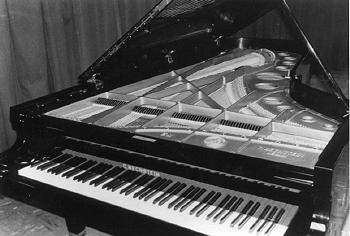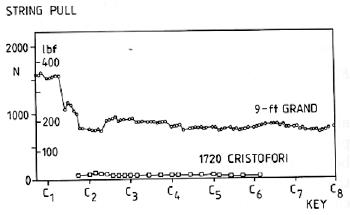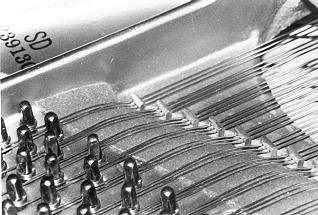 Fig. 29. View of contemporary concert grand plate.
Fig. 29. View of contemporary concert grand plate.

[<- Previous] [Contents of this lecture] [Next ->]
Piano makers gradually learned that pianos could be made louder by increasing the weight and tension of the strings with the result that wooden frames soon became inadequate to support the increased stresses. Until around the beginning of the 19th century the load-bearing structure of pianos was made entirely of wood. By the end of that same century almost all pianos had cast-iron string plates. The metal plate (Fig. 29) brought improved tuning stability and, at least to most modern ears, better tone.
 Fig. 29. View of contemporary concert grand plate.
Fig. 29. View of contemporary concert grand plate.
The need for a stronger supporting structure for the strings is clearly indicated by Fig. 30, which shows the pulling force per string (tension) and the total string pull, calculated for the 1720 Cristofori and for a contemporary concert grand. The average pull of the strings of the Cristofori is only about 70 N (16 lbf, "pound force"), versus about 830 N (190 lbf) for the contemporary piano. The total string load is roughly 7500 N (1700 lbf) for the Cristofori, compared with about 210 000 N (47 000 lbf) for the modern concert grand.
 Fig. 30. String pull for 9-ft (274 cm) contemporary grand and for 1720 Cristofori.
Fig. 30. String pull for 9-ft (274 cm) contemporary grand and for 1720 Cristofori.
The plate must be strong enough not to break under the load of the strings, and it should also be stiff enough to provide good tuning stability. Beyond this, the design of the plate affects the tone of the instrument in many less obvious ways, of which only their general direction will be indicated.
In any stringed instrument the speaking length of each string has two ends. In a piano, one end is connected, via the bridge, to the soundboard, which is expected to radiate sound efficiently. The other end is always connected in some way to the frame of the instrument, which is invariably an inefficient radiator of sound. In modern pianos the forward string termination (the agraffe) is located on the iron string plate, as shown in Fig. 31 This part of the plate should be designed so as not to steal energy away from the strings and the soundboard. The plate should not vibrate appreciably at string frequencies as the piano is being played. Generally, this requires that the plate be rather massive. Plates of concert grand size may weigh 160 - 180 kg.
 Fig. 31. Close-up of forward termination (agraffe panel) of modern grand.
Fig. 31. Close-up of forward termination (agraffe panel) of modern grand.
[<- Previous] [Top] [Contents of this lecture] [Next ->]
This lecture is one of Five lectures on the Acoustics of the piano
© 1990 Royal Swedish Academy of Music